A rare Indo-Portuguese silver model of a "caquesseitao", circa 1700
hollow with screw-on tail, heater and vents compartment with pierced cover, cylindrical spout under prominent tongue and hinged wings, with bird-like feet, scale-chased body, dragon head, prominent tongue and hinged wingsheight 18 1/2 in.; weight 178,1 oz.; 47 cm.; 5050 g.__________________________________________________________________________
Rare modèle en argent en forme de "caquesseitao", Portugal ou Indes portugaises, vers 1700
le corps traversé d'un compartiment, se terminant en queue de poisson dévissable, le couvercle amovible, la prise en forme de lion, le compartiment-réchaud à couvercle ajouré, la langue cachant un bec verseur, les ailes articuléesheight 18 1/2 in.; weight 178,1 oz.; 47 cm.; 5050 g.Condition reportIn overall good condition.A bump on the base of the tail. A small restoration on the tail near the end. Solder repair along spines at upper part of tail, hinges (wings), bottom of crest, and junction of legs and body.Very nice and rare piece. Impressive size.
"In response to your inquiry, we are pleased to provide you with a general report of the condition of the property described above. Since we are not professional conservators or restorers, we urge you to consult with a restorer or conservator of your choice who will be better able to provide a detailed, professional report. Prospective buyers should inspect each lot to satisfy themselves as to condition and must understand that any statement made by Sotheby's is merely a subjective, qualified opinion. Prospective buyers should also refer to any Important Notices regarding this sale, which are printed in the Sale Catalogue.NOTWITHSTANDING THIS REPORT OR ANY DISCUSSIONS CONCERNING A LOT, ALL LOTS ARE OFFERED AND SOLD AS IS" IN ACCORDANCE WITH THE CONDITIONS OF BUSINESS PRINTED IN THE SALE CATALOGUE."Saleroom NoticeThis unusual piece may also have been made in South America (Andes) during the 18th century.
Cette rare piece a probablement aussi était réalisée en Amerique du sud (Région andine) au cours du XVIIeme siècle. ProvenanceIn the collection of the second Conde de Bertiandos (1818-1874), Braga, Palácio dos Biscaínhos;Marqueses of Alegrete;Sotheby's Paris, 26 June 2013, lot 242.____________________________________________
Dans la collection du second Conde de Bertiandos (1818-1874), Braga, Palácio dos Biscaínhos ;Marquis d'Alegrete;Sotheby's Paris, 26 juin 2013, lot 242.LiteratureLisbon, The Ricardo do Espirito Santo Silver Foundation, Exposiçao de Ourivesaria Portuguesa e Francesca, April-May 1955, fig. 55. R. Dos Santos and I. Quilho, Ouriversaria Portuguesa nas Coleccões Particulaes, Lisbon, 1974. L. Castelo Lopez, 'O fantastico na ourivesaria - o Caquesseitao', il Colóquio Português de orivesaria, Escola das Artes da Universidade Católica Portuguesa (UCP), 26-28 September 2008, p. 146, fig. 3.
Associated literature1. Empires beyond the Great Wall: the Heritage of Genghis Kahn, Museum of National History, New York, 1994, ill. 66, p. 104. 2. Luis Castelo Lopes, 'O fantastico na ourivesaria - o Caquesseitao', il Colóquio Português de orivesaria, Escola das Artes da Universidade Católica Portuguesa (UCP), 26-28 September 2008.
ExhibitedLisbon, The Ricardo do Espirito Santo Silver Foundation, Exposiçao de Ourivesaria Portuguesa e Francesca, April-May 1955, no. 112. Lisbon, Casa dos Bicos, XVII Exposiçao de Arte Cultura e Ciência do Conselho da Europa, 1983, no. 9. Catalogue noteThe animal Caquessetaio, or 'ancestors of the devil', was first recorded by the celebrated Portuguese explorer Fernao Mendes Pinto (c. 1509-1583) in his Peregrinacao or Pilgrimages, published posthumusly in Lisbon in 1614: "we also saw here what was for us a very unusual and strange-looking animal that the natives call Caquesseitao, about the size of a big duck, deep black in colour, covered with scales, a row of spines runing down the back...., wings like a bat and a very long, greenish-black tail.... These creatures ... fly as though leaping through the air". The animal which Pinto saw is now thought to be a fruit bat, commonly referred to as the 'flying fox', but his extraordinary description was coloured by earlier mythological beasts found in Oriental and Western art, such as a Chinese faience aquamanile from the Liao dynasty (907-1125)1.
The specific form of the Caquesseitao, with bird-like feet, scale-chased body, dragon head, prominent tongue, and hinged wings, was a recurrent and popular ornament particularly in Indo-Portuguese Art in the late 17th and early 18th century. For example, two 17th century Indo-Portuguese bed-covers, a Portuguese silver salver, circa 1690-1720, and an Indo-Portuguese tortoiseshell casket, 17th century are all decorated with the image of the Caquesseitao.
The model was also developed in silver, its natural shape adapting easily for pouring water as an aquamanile. Seven silver models of Caquesseiato are recorded, including the present example. The majority are in private Portuguese collections (one illustrated in Reynaldo ds Santos and Irene Quilhó, Ourivesaria Portuguesa nas Colecções Particulares, 1959, vol.I, p.76, fig.62). One model is in the Musée National de la Renaissance, Château d'Ecouen. Four of these have pierced sides and detachable covers, traditionally thought to be used for burning incense. But their function could be as well for pouring and keeping water hot. Silver Caquesseitao were particularly prized: the king of Portugal Dom Fernando II kept one in his study in the Palaccio das Necessidades, the Russian prince Feliz Youssopov had one which was confiscated after the Russian Revolution, and Baron James de Rothschild's is now in the Musee d'Ecouen.
This piece was in the collection of the second Conde de Bertiandos (1818-1874), Braga, Palácio dos Biscaínhos. The Conde made a copy which was gifted to king Dom Fernando II who describes it in his personal inventory in 1866 as a copy of the one in the counts collection, which was " made in India, undoubtedly around 1500". T
Then by descendance this rare piece was in the collection of the Marqueses de Alegrete. Manuel Teles da Silva (1641-1709), 2nd Earl of Vila Maior, became the first Marquis de Alegrete in 1687, after negotiating the marriage of King Dom Pedro II of Portugal (1648-1706) with Maria Sofia of the Palatinate (1666-1699). He participated in the battle of Ameixal in 1663 during the Portuguese Restoration War and was made colonel at the age of 27. He was one of the negotiators of the Methuen Treaty in 1703, a commercial treaty which cemented the relationship between Portugal and England. The Marques built a farm called Quinta Alegrete, which is now part of the Portuguese National Heritage.
A rare Indo-Portuguese silver model of a "caquesseitao", circa 1700
hollow with screw-on tail, heater and vents compartment with pierced cover, cylindrical spout under prominent tongue and hinged wings, with bird-like feet, scale-chased body, dragon head, prominent tongue and hinged wingsheight 18 1/2 in.; weight 178,1 oz.; 47 cm.; 5050 g.__________________________________________________________________________
Rare modèle en argent en forme de "caquesseitao", Portugal ou Indes portugaises, vers 1700
le corps traversé d'un compartiment, se terminant en queue de poisson dévissable, le couvercle amovible, la prise en forme de lion, le compartiment-réchaud à couvercle ajouré, la langue cachant un bec verseur, les ailes articuléesheight 18 1/2 in.; weight 178,1 oz.; 47 cm.; 5050 g.Condition reportIn overall good condition.A bump on the base of the tail. A small restoration on the tail near the end. Solder repair along spines at upper part of tail, hinges (wings), bottom of crest, and junction of legs and body.Very nice and rare piece. Impressive size.
"In response to your inquiry, we are pleased to provide you with a general report of the condition of the property described above. Since we are not professional conservators or restorers, we urge you to consult with a restorer or conservator of your choice who will be better able to provide a detailed, professional report. Prospective buyers should inspect each lot to satisfy themselves as to condition and must understand that any statement made by Sotheby's is merely a subjective, qualified opinion. Prospective buyers should also refer to any Important Notices regarding this sale, which are printed in the Sale Catalogue.NOTWITHSTANDING THIS REPORT OR ANY DISCUSSIONS CONCERNING A LOT, ALL LOTS ARE OFFERED AND SOLD AS IS" IN ACCORDANCE WITH THE CONDITIONS OF BUSINESS PRINTED IN THE SALE CATALOGUE."Saleroom NoticeThis unusual piece may also have been made in South America (Andes) during the 18th century.
Cette rare piece a probablement aussi était réalisée en Amerique du sud (Région andine) au cours du XVIIeme siècle. ProvenanceIn the collection of the second Conde de Bertiandos (1818-1874), Braga, Palácio dos Biscaínhos;Marqueses of Alegrete;Sotheby's Paris, 26 June 2013, lot 242.____________________________________________
Dans la collection du second Conde de Bertiandos (1818-1874), Braga, Palácio dos Biscaínhos ;Marquis d'Alegrete;Sotheby's Paris, 26 juin 2013, lot 242.LiteratureLisbon, The Ricardo do Espirito Santo Silver Foundation, Exposiçao de Ourivesaria Portuguesa e Francesca, April-May 1955, fig. 55. R. Dos Santos and I. Quilho, Ouriversaria Portuguesa nas Coleccões Particulaes, Lisbon, 1974. L. Castelo Lopez, 'O fantastico na ourivesaria - o Caquesseitao', il Colóquio Português de orivesaria, Escola das Artes da Universidade Católica Portuguesa (UCP), 26-28 September 2008, p. 146, fig. 3.
Associated literature1. Empires beyond the Great Wall: the Heritage of Genghis Kahn, Museum of National History, New York, 1994, ill. 66, p. 104. 2. Luis Castelo Lopes, 'O fantastico na ourivesaria - o Caquesseitao', il Colóquio Português de orivesaria, Escola das Artes da Universidade Católica Portuguesa (UCP), 26-28 September 2008.
ExhibitedLisbon, The Ricardo do Espirito Santo Silver Foundation, Exposiçao de Ourivesaria Portuguesa e Francesca, April-May 1955, no. 112. Lisbon, Casa dos Bicos, XVII Exposiçao de Arte Cultura e Ciência do Conselho da Europa, 1983, no. 9. Catalogue noteThe animal Caquessetaio, or 'ancestors of the devil', was first recorded by the celebrated Portuguese explorer Fernao Mendes Pinto (c. 1509-1583) in his Peregrinacao or Pilgrimages, published posthumusly in Lisbon in 1614: "we also saw here what was for us a very unusual and strange-looking animal that the natives call Caquesseitao, about the size of a big duck, deep black in colour, covered with scales, a row of spines runing down the back...., wings like a bat and a very long, greenish-black tail.... These creatures ... fly as though leaping through the air". The animal which Pinto saw is now thought to be a fruit bat, commonly referred to as the 'flying fox', but his extraordinary description was coloured by earlier mythological beasts found in Oriental and Western art, such as a Chinese faience aquamanile from the Liao dynasty (907-1125)1.
The specific form of the Caquesseitao, with bird-like feet, scale-chased body, dragon head, prominent tongue, and hinged wings, was a recurrent and popular ornament particularly in Indo-Portuguese Art in the late 17th and early 18th century. For example, two 17th century Indo-Portuguese bed-covers, a Portuguese silver salver, circa 1690-1720, and an Indo-Portuguese tortoiseshell casket, 17th century are all decorated with the image of the Caquesseitao.
The model was also developed in silver, its natural shape adapting easily for pouring water as an aquamanile. Seven silver models of Caquesseiato are recorded, including the present example. The majority are in private Portuguese collections (one illustrated in Reynaldo ds Santos and Irene Quilhó, Ourivesaria Portuguesa nas Colecções Particulares, 1959, vol.I, p.76, fig.62). One model is in the Musée National de la Renaissance, Château d'Ecouen. Four of these have pierced sides and detachable covers, traditionally thought to be used for burning incense. But their function could be as well for pouring and keeping water hot. Silver Caquesseitao were particularly prized: the king of Portugal Dom Fernando II kept one in his study in the Palaccio das Necessidades, the Russian prince Feliz Youssopov had one which was confiscated after the Russian Revolution, and Baron James de Rothschild's is now in the Musee d'Ecouen.
This piece was in the collection of the second Conde de Bertiandos (1818-1874), Braga, Palácio dos Biscaínhos. The Conde made a copy which was gifted to king Dom Fernando II who describes it in his personal inventory in 1866 as a copy of the one in the counts collection, which was " made in India, undoubtedly around 1500". T
Then by descendance this rare piece was in the collection of the Marqueses de Alegrete. Manuel Teles da Silva (1641-1709), 2nd Earl of Vila Maior, became the first Marquis de Alegrete in 1687, after negotiating the marriage of King Dom Pedro II of Portugal (1648-1706) with Maria Sofia of the Palatinate (1666-1699). He participated in the battle of Ameixal in 1663 during the Portuguese Restoration War and was made colonel at the age of 27. He was one of the negotiators of the Methuen Treaty in 1703, a commercial treaty which cemented the relationship between Portugal and England. The Marques built a farm called Quinta Alegrete, which is now part of the Portuguese National Heritage.
.jpg)

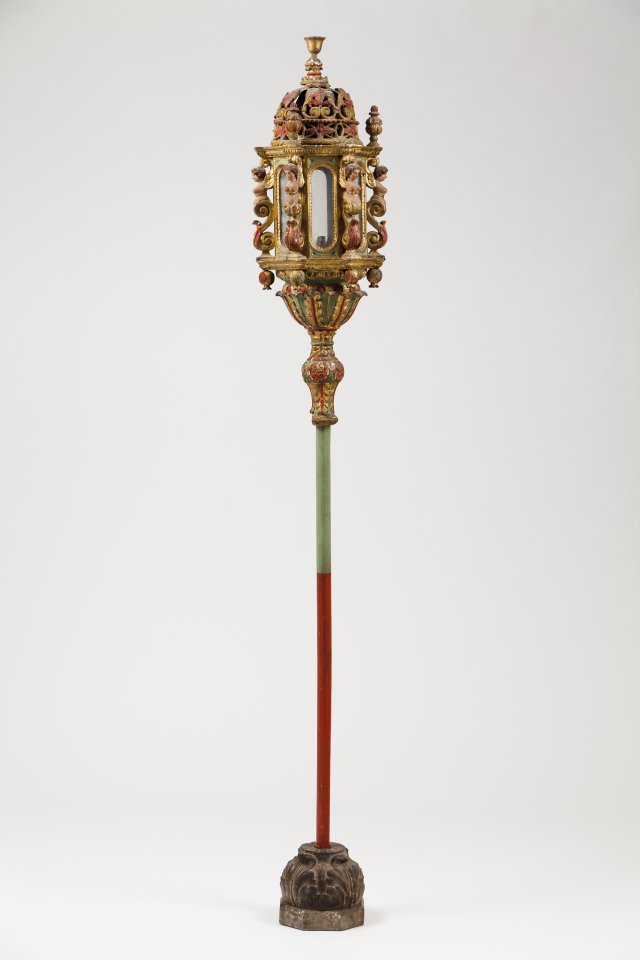
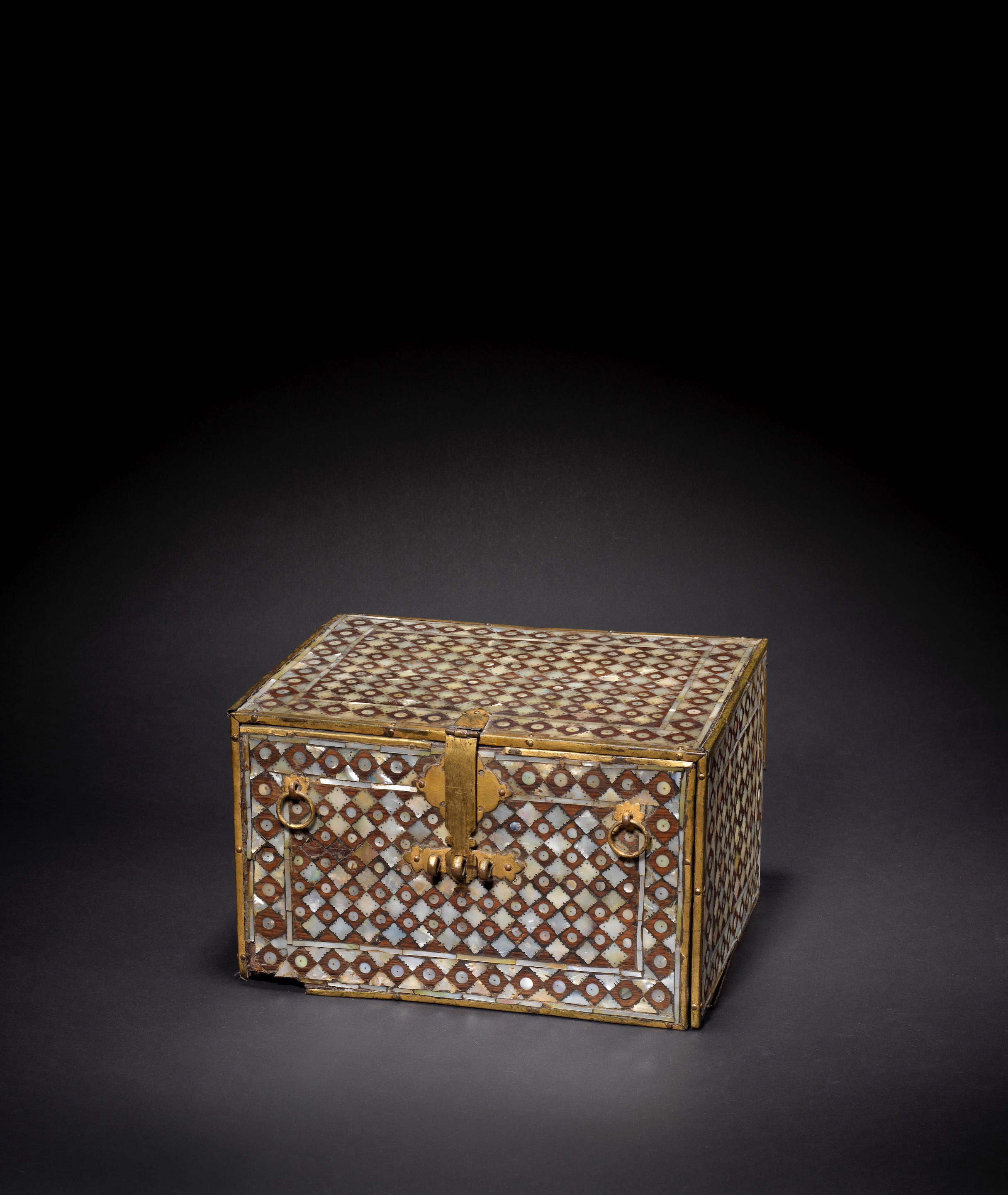
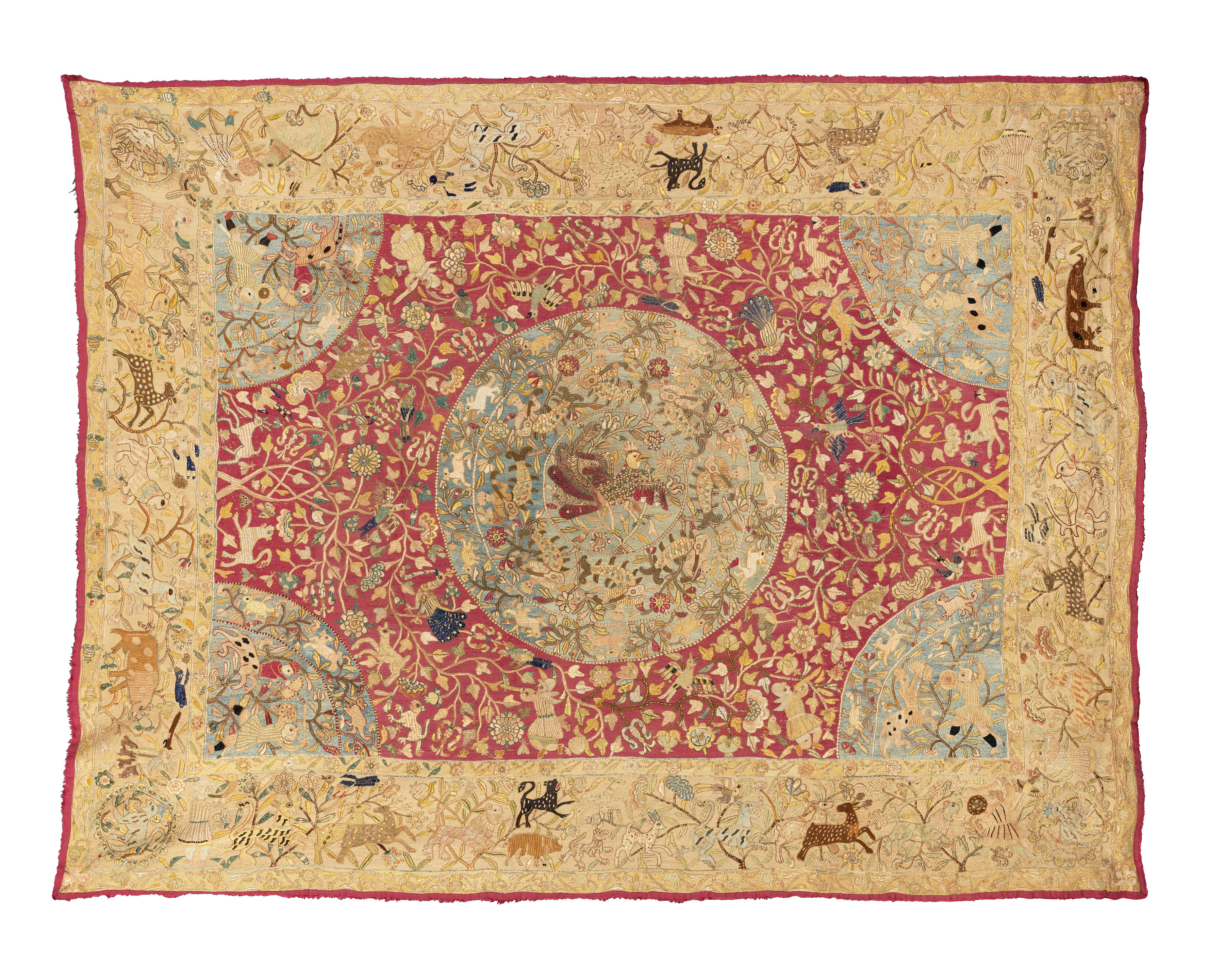
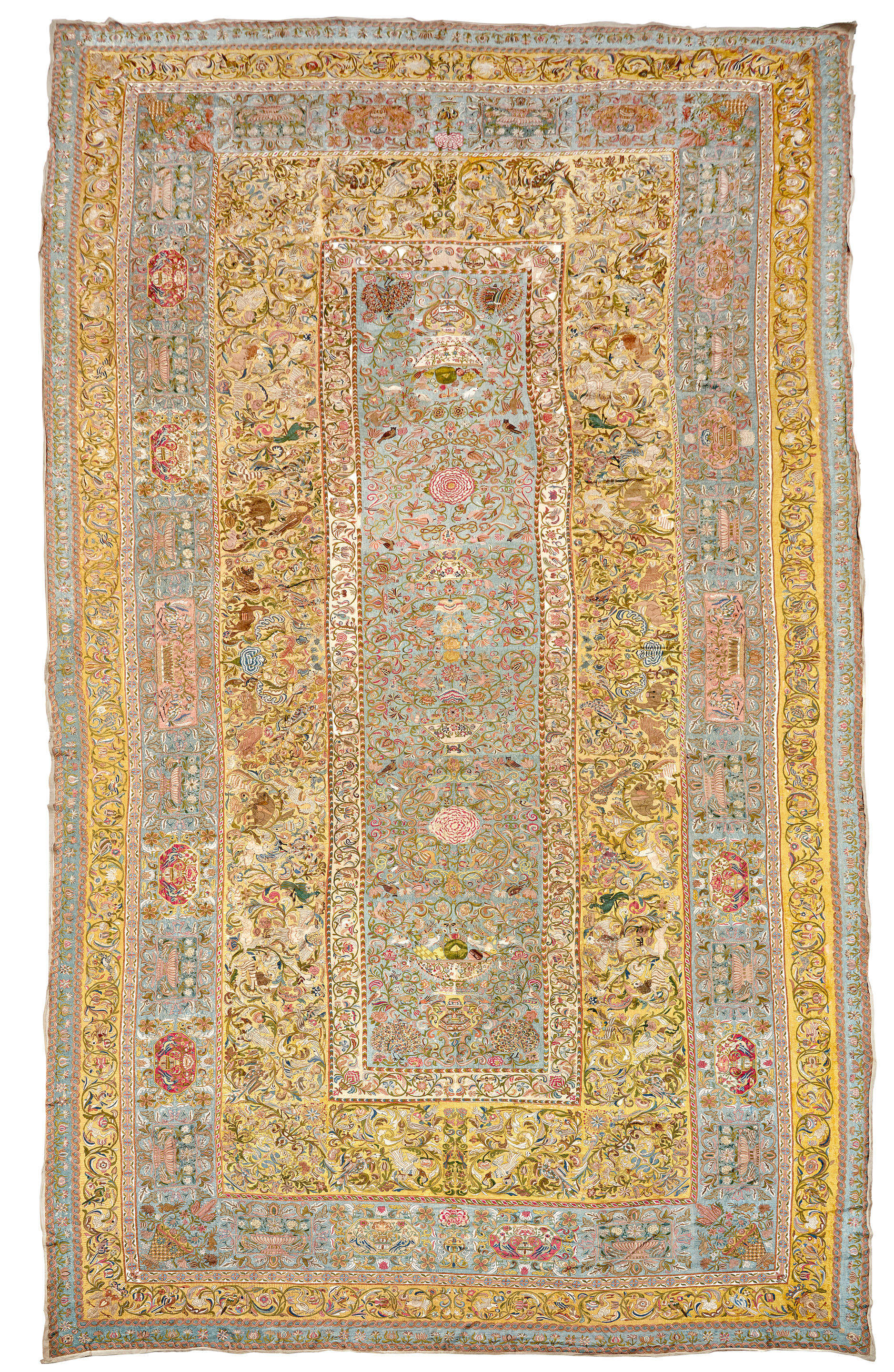






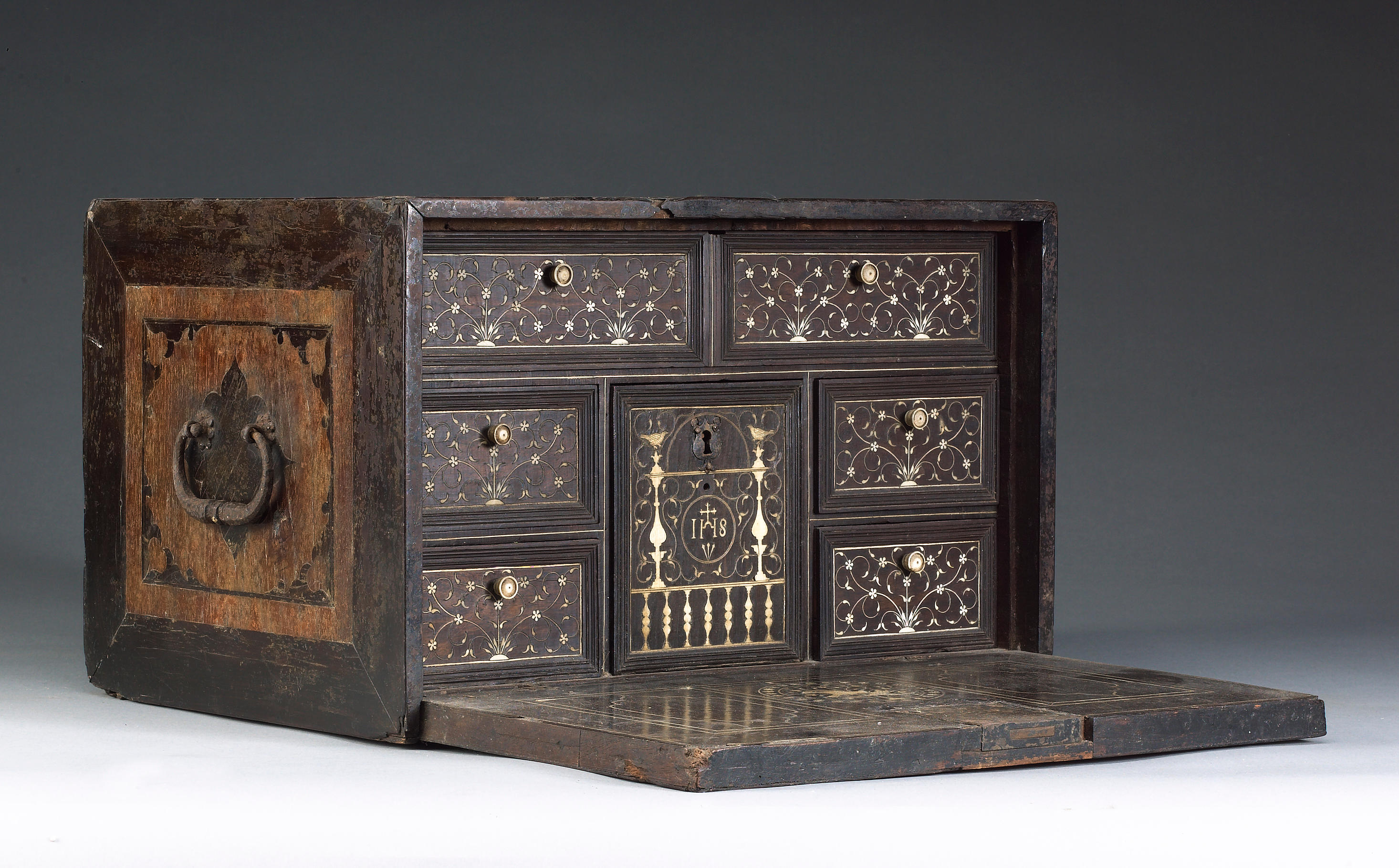

Testen Sie LotSearch und seine Premium-Features 7 Tage - ohne Kosten!
Lassen Sie sich automatisch über neue Objekte in kommenden Auktionen benachrichtigen.
Suchauftrag anlegen